Power Toys 1.0 for Windows CE 1.0xChris Tilley | Editor-in-Chief Power Toys have long been applications of the technically minded user. A little fun in a small package created by the Windows OS shell team. Like with the original Power Toys release back in the day of Windows 95, there have been Power Toys applications released by the Windows CE team for several generations of Handheld PC devices. For the benefit of posterity we're going to take a look back at the first Windows CE Power Toys release in 1997. The original Power Toys for Windows CE 1.0 were released in February 1997 and remains one of the few applications that Microsoft put out for Handheld PC 1.0 devices. One of the best features about it is that it's completely free! With the benefit if hindsight, with us now almost being at Windows CE 5, it's too easy to look at Windows CE 1 and cringe at it's idiosyncrasy's, laugh at it's eccentricities and generally lay into it. However from the perspective of users back in 1997, we have to remember that this was simply a revolution. Windows CE 1 was what the artisans of Naples and Venice were to the renaissance, without it we simply wouldn't have the PDA heyday that we currently do... at least not with Microsoft as a key player. There are Windows CE 1 users out there, and it's our writ to support them, so with that in mind, we take a look at the original Power Toys for CE. The Power Toys are a free 1.3 MB download, and are designed for use with Handheld PC Explorer 1.1. Simply H/PC Explorer is the only way that you can install them. The full installation footprint is roughly 700 KB if you install all of the components. This will vary as to whether you are installing on a SH3 or MIPS based device. MIPS installations are always larger than SH3 ones due to differences in how the code is compiled for each. Given that Original Windows CE 1.0 devices only Had 1MB of available storage memory, the use of the Power Toys may be something of a luxury on the very early devices as the entire suite must be installed in to Main Memory. What do you get for your 700 KB? Well, a small set of utilities which include:
Cascading MenuThe Power Toys release for CE 1's most notable inclusion is Cascading Menu. Cascading Menu crucially tries to addresses one of the biggest failings of Windows CE 1, the lack of a cascading start menu. 
Of course, this flaw wasn't fixed until the release of Windows CE 2.0. So the Power Toys team redressed the balance by introducing the Cascading Menu Power Toy. Cascading Menu introduced a proper cascading system for the 'Programs' folder of the Start Menu, but went several steps further by also adding access to the Control Panel, Recent Documents, My Handheld PC, My Documents as well as several other system folders all from the one compact utility. It is worth noting that this functionality didn't arrive on mainstream windows until the 1999 release of Windows 2000! 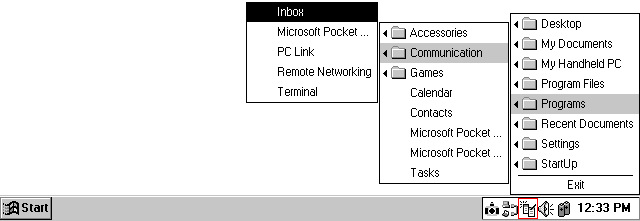
Using Cascading Menu is simple. Tap the new Tray Icon (Highlighted) to bring up the first menu, and simply navigate down the hierarchy of folders until you get to where you want to be. It's exactly like using the real Start Menu. As shown Cascading Menu operates from the Right to the left. If - while navigating My Handheld PC say - you get the the left hand side of the screen. The next layer will simply loop back over the top of the previous and head back towards the right hand side. 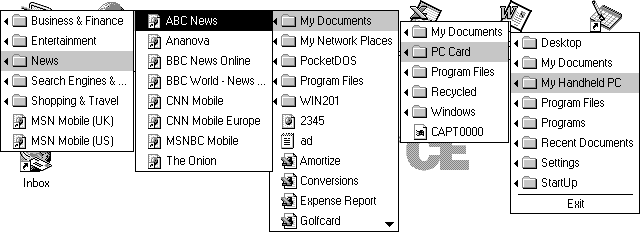
One noticeable absence from the Cascading Menu are the application icons. The logic here is simple. The icons slow down load time as the screen has to be redrawn. Microsoft claim that this offer's a 300% performance increase on using the regular start menu. A claim they sill touted when Cascading Menu was included in the Windows CE 2.0 Power Toys. For those who crave icons, if you wait a few seconds after opening Cascading Menu they will appear. Cascading Menu is very simple to use, and more than makes up for the shortcomings of the Start Menu itself. While it may draw faster, the loss of the icons may slow you down, you don't realise how much you rely on the icons until they're not there. Also having to train yourself to go to the bottom right, rather than the bottom left may take some time. However over all, under Windows CE 1, this is a much needed, if undocumented application. Paint for Windows CEPaint is one of the quintessential applications that scream "Windows". Unfortunately Windows CE was lacking this leviathan of the start menu. Once again Power Toys comes to the rescue. Providing you with that pixely, uncontrollable doodle pad that we know you all crave! 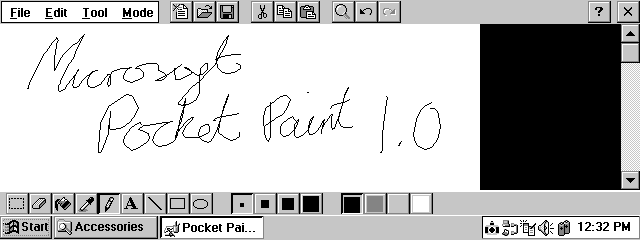
On the surface, Pocket Paint does everything that you'd expect it to. Draw, fill, select type. Just like any other version of Paint. It's only capable of supporting 4 tones of grey, not a problem under Windows CE 1, as devices can only display 4 tones of grey. Now for something you probably didn't know... 
My biggest gripe with Pocket Paint is that is doesn't support Windows Standard BitMap files (.bmp). It only supports the native Windows CE .2bp format. Requiring you to convert images to 2bp by other means if you wish to edit them on the device. MuteMute is a wolf in sheeps clothing. It's deception is obvious. It looks like the Windows Volume Control tray icon. You have to remember however that it does EXACTLY what it says on the tin.
It mutes! It does also unmute too, in case you were wondering, but that is all. Unlike the third party application Sound Widget - which performs as you'd expect - this simply does as above. Tap it to turn the sound off. Tap it again to turn it back on. Remote ControlYou can't fail to miss the irony when Windows CE 1 is able to do something that current generation devices running Microsoft code cannot. This is just such an example. 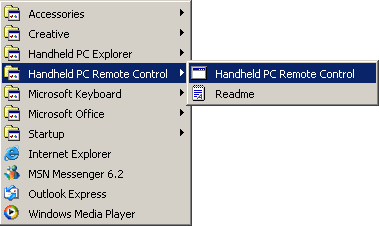
Assuming that you've connected to your Handheld PC, Remote will start, and load the H/PC's screen on your desktop. 
There is Windows CE 1 in all it's glory on my desktop but where's half of the screen? With just one catch. I'm a Windows NT man, so all my computers run Windows NT4, 2000, XP or 2003. Once you've followed our guide to connecting CE 1 to Windows 2000 or XP you'll have H/PC Explorer synchronisation, but alas Remote simply doesn't seem to want to work for more than a few seconds under Windows 2000. Which was something of a disappointment to me. Control Panel Annunciators
Their presence is hidden after installation of the Power Toys. You need to set it up manually. Windows CE will have a think for a moment and the screen will redraw. At which point the associated icon of the control Panel applet you chose will appear in the system tray.
Additional Sound SchemesFor those who like to customise their device, Microsoft have included some of the Additional Sound schemes from Windows 95 in the Power Toys suite, a welcome addition if you like that sort of thing. I personally tend to minimise the number of sound events my device uses. 
The three schemes included in Power Toys are Analog, Metallic and Organic. To enable them you simply select the scheme from the Volume & Sounds Properties applet in the Windows CE Control Panel. If you wanted to listen to the schemes, they are available to download in an extracted format from the HPC:Factor Themes section. Additional WallpapersShouldn't need to cover this in any detail. 9 fairly classic Windows wallpapers from Windows 3.x. Again they're available from the Themes section should you want them. 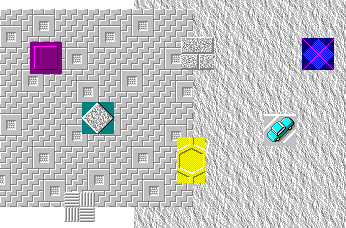
ConclusionOver all the Power Toys are what you would expect to see. Mostly frivolous, with one or two things that let you see the capabilities of Windows CE. You have to remember that wile there are a lot of flaws demonstrated here in the suite, and also in Windows CE 1. Windows CE was primal at this time. You can learn more about Windows CE's history from our Overview of Windows CE. Power Toys, as much Cliché' as I am! System RequirementsWindows CE 1.0 only Chris Tilley More information on Microsoft Power Toys 1.0 for Windows CE 1.0 can be found in the Software Compatibility List. Ratings
Further DiscussionLet us know what you thought of this review and the Microsoft Power Toys 1.0 for Windows CE 1.0 in the Community Forums! |

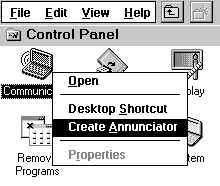 Precisely! That's what I said way back when I first heard that mouthful. Essentially it's just an elaborate way of saying we're going to put Control Panel applets on the taskbar.
Precisely! That's what I said way back when I first heard that mouthful. Essentially it's just an elaborate way of saying we're going to put Control Panel applets on the taskbar.